What is the purpose of the Connecticut A 62 form?
The Connecticut A 62 form is an application for a special permit that allows individuals with a suspended operator's license to operate a motor vehicle specifically for commuting to and from work. This form is essential for individuals seeking to regain limited driving privileges while adhering to the conditions set by the Connecticut Department of Motor Vehicles (DMV).
What are the eligibility requirements to apply for a special permit?
To be eligible for a special permit, applicants must have a suspended operator's license. The permit is intended solely for commuting purposes to work. Additionally, the applicant must demonstrate that a significant hardship exists without access to a vehicle and outline efforts made to seek alternative transportation. Each employer must complete a separate application if the individual works multiple jobs.
How much does it cost to apply for the permit?
The application requires a non-refundable fee of $100. This fee must be submitted in the form of a check or money order made payable to the DMV. It is crucial to include this payment when submitting the application to avoid delays or denial.
What information is required on the A 62 form?
The A 62 form requires the applicant's personal details, such as their name, date of birth, operator license number, and both the mailing and residence addresses. Furthermore, the form asks for details about the employer, including the name, address, and contact information, as well as specifics about the applicant's work schedule and the commuting distance and time. Applicants must also describe any hardships faced due to the current suspension.
What could lead to denial of the special operator's permit?
Several factors could contribute to the denial of a special operator's permit. The DMV may deny the application if the applicant does not provide enough evidence of a significant hardship or fails to confirm their employment status. Additionally, if the applicant's driving history indicates that they do not meet eligibility criteria or if they are found ineligible for any other reason, the application may be rejected.
What are the potential consequences for misusing the special permit?
Misusing the special permit can lead to serious legal consequences. Operating a vehicle outside of the authorized hours can result in arrest. If the permit holder engages in driving unrelated to the permitted purposes, they may face a civil penalty of up to $500. Furthermore, any alterations or improper use of the permit could result in criminal penalties, highlighting the importance of adhering strictly to the permit's regulations.

